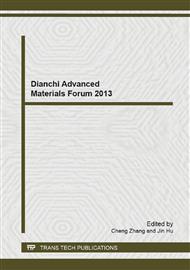[1]
A. R. Boccaccini, I. MacLaren, M. H. Lewis, C. B. Ponton, Electrophoretic deposition infiltration of 2-D woven SiC fiber mats with mixed sols of mullite composition, Journal of the European Ceramic Society. 17 (1997) 1545-1550.
DOI: 10.1016/s0955-2219(97)00025-3
Google Scholar
[2]
C. Kaya, F. Kaya, H. Mori, Damage assessment of alumina fiber-reinforced mullite ceramic matrix composites subjected to cyclic fatigue at ambient and elevated temperatures, Journal of the European Ceramic Society. 22 (2002) 447-452.
DOI: 10.1016/s0955-2219(01)00320-x
Google Scholar
[3]
J. Wu, F. R Jones, P. F James, Continuous fiber reinforced mullite matrix composites by sol-gel processing Part I Fabrication and microstructures, Journal of Material Science. 32 (1997) 3361-3368.
Google Scholar
[4]
K. K. Chawla, Interface engineering in mullite fiber/mullite matrix composites, Journal of the European Ceramic Society. 28 (2008) 447-453.
DOI: 10.1016/j.jeurceramsoc.2007.03.008
Google Scholar
[5]
S. Park, M. K. Seo, Y. S. Lee, Surface characteristics of fluorine-modified PAN-based carbon fibers, Carbon. 41 (2003) 723-730.
DOI: 10.1016/s0008-6223(02)00384-6
Google Scholar
[6]
K. W. Dai, H. J. Peng, Q. S. Ma, H. T. Liu, Preparation and mechanical properties of 3D-Cf/mullite composites fabricated by sol-gel process, Ceramic Transactions. to be published.
DOI: 10.1002/9781118932995.ch39
Google Scholar
[7]
K. A. Keller, T. Mah, T. A. Parthasarathy, C. M. Cooke, Fugitive interfacial carbon coatings for Oxide/Oxide composites, Journal of the American Ceramic Society. 83(2) (2000) 329-336.
DOI: 10.1111/j.1151-2916.2000.tb01194.x
Google Scholar
[8]
J. -S. Ha, K. K. Chawla, Mechanical behavior of mullite composites reinforced with mullite fibers, Material Science and Engineering. A203 (1995) 171-176.
DOI: 10.1016/0921-5093(95)09874-7
Google Scholar
[9]
E. G. Marotta, M. A. Lambert, L. S. Fletchert, Evaluation of nonmetallic coatings and films for thermal control applications, Journal of Thermophysics and Heat Transfer. 8(2) (1994) 349-357.
DOI: 10.2514/3.545
Google Scholar
[10]
H. Schneider, S. Komarneni, Mullite. WILEY-VCH Verlag GmbH & Co. KGaA, Weinheim, 2005, pp.235-237.
Google Scholar
[11]
Y. Park, M. J. McNallan, D. P. Butt, Endothermic reactions between mullite and silicon carbide in an argon plasma environment, Journal of the American Ceramic Society. 81(1) (1998) 233-236.
DOI: 10.1111/j.1151-2916.1998.tb02322.x
Google Scholar


